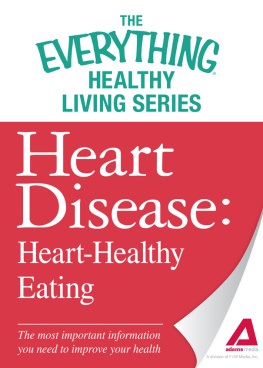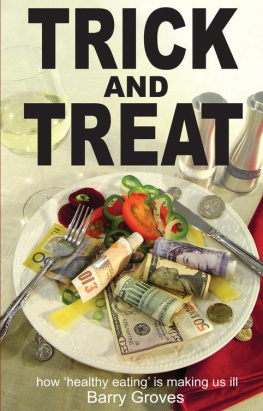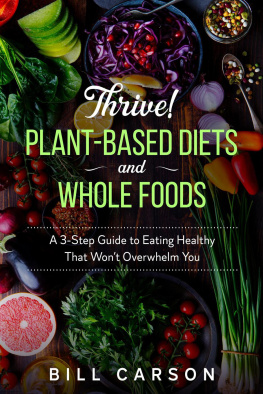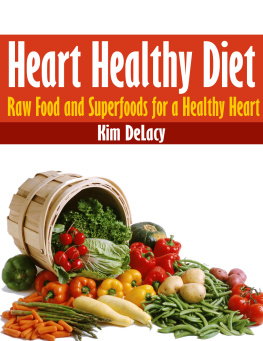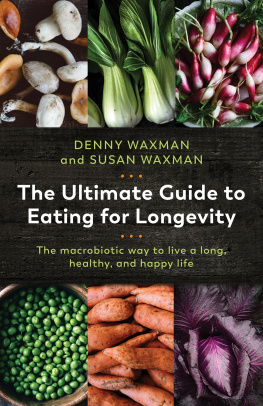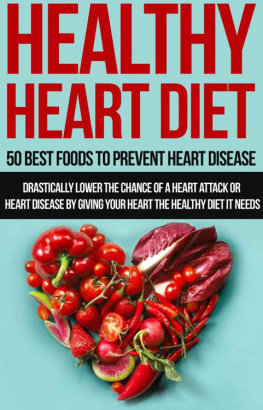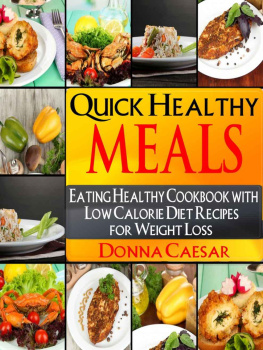Healthy Eating: Understanding Foods and our Body
Here you can read online Healthy Eating: Understanding Foods and our Body full text of the book (entire story) in english for free. Download pdf and epub, get meaning, cover and reviews about this ebook. City: London, year: 2005, publisher: Publishing House, My Ebook;IPC Connect, genre: Romance novel. Description of the work, (preface) as well as reviews are available. Best literature library LitArk.com created for fans of good reading and offers a wide selection of genres:
Romance novel
Science fiction
Adventure
Detective
Science
History
Home and family
Prose
Art
Politics
Computer
Non-fiction
Religion
Business
Children
Humor
Choose a favorite category and find really read worthwhile books. Enjoy immersion in the world of imagination, feel the emotions of the characters or learn something new for yourself, make an fascinating discovery.
- Book:Healthy Eating: Understanding Foods and our Body
- Author:
- Publisher:Publishing House, My Ebook;IPC Connect
- Genre:
- Year:2005
- City:London
- Rating:3 / 5
- Favourites:Add to favourites
- Your mark:
- 60
- 1
- 2
- 3
- 4
- 5
Healthy Eating: Understanding Foods and our Body: summary, description and annotation
We offer to read an annotation, description, summary or preface (depends on what the author of the book "Healthy Eating: Understanding Foods and our Body" wrote himself). If you haven't found the necessary information about the book — write in the comments, we will try to find it.
Unknown: author's other books
Who wrote Healthy Eating: Understanding Foods and our Body? Find out the surname, the name of the author of the book and a list of all author's works by series.
Healthy Eating: Understanding Foods and our Body — read online for free the complete book (whole text) full work
Below is the text of the book, divided by pages. System saving the place of the last page read, allows you to conveniently read the book "Healthy Eating: Understanding Foods and our Body" online for free, without having to search again every time where you left off. Put a bookmark, and you can go to the page where you finished reading at any time.
Font size:
Interval:
Bookmark:
Healthy Eating
Understanding Foods and our Body
~~**~~
Published by My Ebook Publishing House at Smashwords
Copyright My Ebook Publishing House
Smashwords Edition, License Notes
This ebook is licensed for your personal enjoyment only. This ebook may not be re-sold or given away to other people. If you would like to share this book with another person, please purchase an additional copy for each recipient. If youre reading this book and did not purchase it, or it was not purchased for your use only, then please return to Smashwords.com and purchase your own copy. Thank you for respecting the hard work of this author.
~~**~~
~~**~~
Other Titles from My Ebook Publishing House:


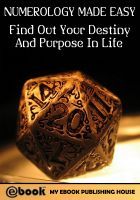
~~**~~
CONTENT
1. The energetic balance of the human body
The provision of energy to the human body is a vital function, without which breathing, the activity of the heart, of the brain, the liver, the muscular activity, the growth function, reproduction and so on wouldnt be possible. This energy is produced as a result of the burning in the human body of some substances called circulating. They are represented by monosaccharides, fatty acids and amino acids, substances that come from viands, where they are found in the form of the nutritious factors called carbohydrates, lipids and protein. The monosaccharides (glucose, fructose) are found as such, or in the shape of polysaccharides (starch). The fatty acids come from lipids, and the amino acids, from protein.
For the carbohydrates, lipids and protein to transform in the respective substances, necessary for the production of energy, they are subjected to the digestion and body absorption processes, their burning being produced in the liver, the muscles, the adipose tissue and so on. The energy production occurs particularly on the strength of carbohydrates and lipids, the protein having a special part in growth and reproduction.
In the case of the total lack of use of the created energy, and this phenomenon occurs when the physical effort of the man is reduced, the carbohydrates, the lipids and the unused protein deposit as retentions in the central repositories, among which the most important one are the adipose tissue, the liver, the muscles, wherefrom they are used when needed (in an increased physical effort). The adipose tissue, being constituted predominantly of lipids, the exaggerated consumption of alimentary fats, in the case of reduced physical effort lead to the beyond measure growth of the adipose retentions, causing the apparition of obesity.
In a normal body, between the energy production and consumption, a balance is formed. The energy production occurs behind the oxidation (burning) of glucose, fatty acids and amino acids resulted from carbohydrates, lipids and protein, in the digestion process, and all the vital processes from the body (the blood circulation, the muscle contraction, the thermoregulation and so on) are effectuated with energy consumption.
In the case when the energetic needs are not covered by the viands contribution, the body calls on the retentions of its own tissues. A minimum caloric energy quantity is indispensable to the body for maintaining its vital functions. This was called basal metabolism , or a minimum energy consumption and is defined in the following manner: the energy necessary to an individual on standby, in physical and psychical repose, after at least 12 hours from the last meal and at least 24 hours after the protein ingestion, in the thermic neutrality conditions, namely at an ambient temperature of 20-21 degrees.
Therefore, even in the case of maintaining the body in a complete repose state, it needs a viands consumption, in a certain caloric value, necessary to the production of an energy for maintaining it in a heart, lungs, respiration, blood circulation and so on functioning state. The value of the basal metabolism, namely of this minimum energy, varies according to a series of factors such as: the weight of the individual, the body size, the shape of the body, age, gender, various physiological states (pregnancy, nursing) or environment factors (warm or cold climate). The basal metabolism can go up or down depending on some glandular diseases also.
Usually, the calculation of the basal metabolism, namely of the minimum energy consumptions necessary for the repose state, is made by taking into account that the normal adult need a calorie for each kilogram of his weight per hour for an ideal weight. For example, an individual with an ideal weight of 70 kg will need one day, only for maintaining his vital functions, 1680 calories (1*70*24 = 1680). However, it must be taken into account that the basal energetic needs are increased in a child, these then reducing gradually with increasing age.
Previously, it was mentioned that the energy consumptions necessary to physical muscular activity, for the ingestion of food and for the constant maintenance of the body weight, the body needs an energetic supplement. In addition to the amount of calories necessary to the minimum energy consumption, an amount of calories that varies depending on the intensity and duration of the made efforts is added. Therefore, the factual assessment of the energetic balance depends of the report between the quantity and quality of the ingested aliments and of the manner in which the accomplished energy is consumed, the main consumption modality being the physical effort, movement. Therefore, we can state that the rational nutrition, on one hand, and the consumption of energy by exercise and movement, on the other hand, are the main basic factors of the energetic balance. The additional consumption of necessary energy was measured by researchers for various categories of physical activities and professions, on which tables that indicate the necessary calories for each one of these activities were drawn up.
In view of the suitable calculation of the necessary calories, an alimentary ration was established, a ration that is considered to be the ingested aliments quantity that satisfies qualitatively and quantitatively the energy and nutrition needs, expressed in aliments, nutritious factors and calories, necessary to the man for a period of time, usually of 24 hours.
For protein, the nutritious factors quantity is calculated by taking 1,2 1,5 g/kg of ideal body weight per day, and for the carbohydrates that represent the basic energetic element, 4-8 g/kg of ideal body weight per day. Reporting these numbers to the daily caloric values, the protein ration represents 10-15% of this value, the lipids one, 25-35%, and the carbohydrates one, 55-65%. It must be remembered that these values vary according to age, work circumstances, effort, physiological state (pregnancy, nursing), growing child or various diseases.
2. Proteins, lipids and carbohydrates
Proteins, from a chemical point of view, are substances that have in their composition carbon particles, hydrogen, oxygen, nitrogen and sometimes, sulfur. Entering the structure of all the cells of the body, they act on their growth and restoration. In certain situations, the proteins participate to the attainment of the energy necessary to the human body. From the burning process, an energy quantity equate with 4,1 calories per 1 g of burnt proteins.
The proteins are constituted from amino acid chains. These were named the body building stones. From the known amino acids, a part is considered essential because they cannot be synthetized by man. They must be brought daily by alimentation, in adequate quantities. The others were called unessential, as they can be synthetized from other internal substances of the body. The difference between these 2 amino acid categories is, therefore, constituted only by the manner in which they can be synthetized, both the essential amino acids, as well as the nonessential ones, being equally important for the formation of their own proteins.
Next pageFont size:
Interval:
Bookmark:
Similar books «Healthy Eating: Understanding Foods and our Body»
Look at similar books to Healthy Eating: Understanding Foods and our Body. We have selected literature similar in name and meaning in the hope of providing readers with more options to find new, interesting, not yet read works.
Discussion, reviews of the book Healthy Eating: Understanding Foods and our Body and just readers' own opinions. Leave your comments, write what you think about the work, its meaning or the main characters. Specify what exactly you liked and what you didn't like, and why you think so.


